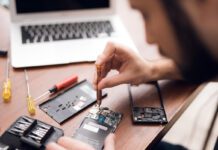
A new report – “Improving the loops of plastics in electronics” – shares the conclusions from a recent workshop on Waste of Electrical and Electronic equipment (WEEE) plastics, organized by BSEF, the International Bromine Council, during the International Electronics recycling conference (IERC 2022).
The discussion revolved around getting more plastic recycle from WEEE back into the production cycle, and how this can be increased by capacity increases and innovations, while also decreasing the dispersion of POP Brominated Flame Retardants (BFRs) substances. The discussions revolved around the following topics:
1. Stopping the major leaks of POPs from WEEE
To stop the dispersion of POP BFRs and reduce their loop, the most effective action is to improve the collection rate of WEEE, as was clearly shown by Federico Magalini in his presentation.
2. Increasing the amounts of plastics recycled from WEEE
To increase the quantity of plastics recovered from WEEE, innovations to recover PA, filled PP, PMMA and PC are needed. These plastics are in the same density ranges as those plastics with BFRs and they are presently lost. Innovations are underway but need time and alliances between producers and recyclers.
3. The assessment of substances must be unified and stable
By the virtue of the circle, the legal assessment of a substance should be stable all along its cycle. Hazardous substances in waste could be managed by risk when the material is under control during the product stages and during the waste stages.
4. The further development of a circular economy for WEEE plastics.
Today over 3 million Metric Tons of tech-plastic are used in new electronics. Recycling these plastics makes a lot of sense from an environmental point of view, as the energy for the extraction, refining and polymerization and kept in these recycled polymer chains, thus resulting in enormous CO2 and energy savings compared to the production of virgin tech plastics. Today only a small quantity of the WEEE plastics are currently truly circular and this needs to be increased.
Read the full article HERE.








